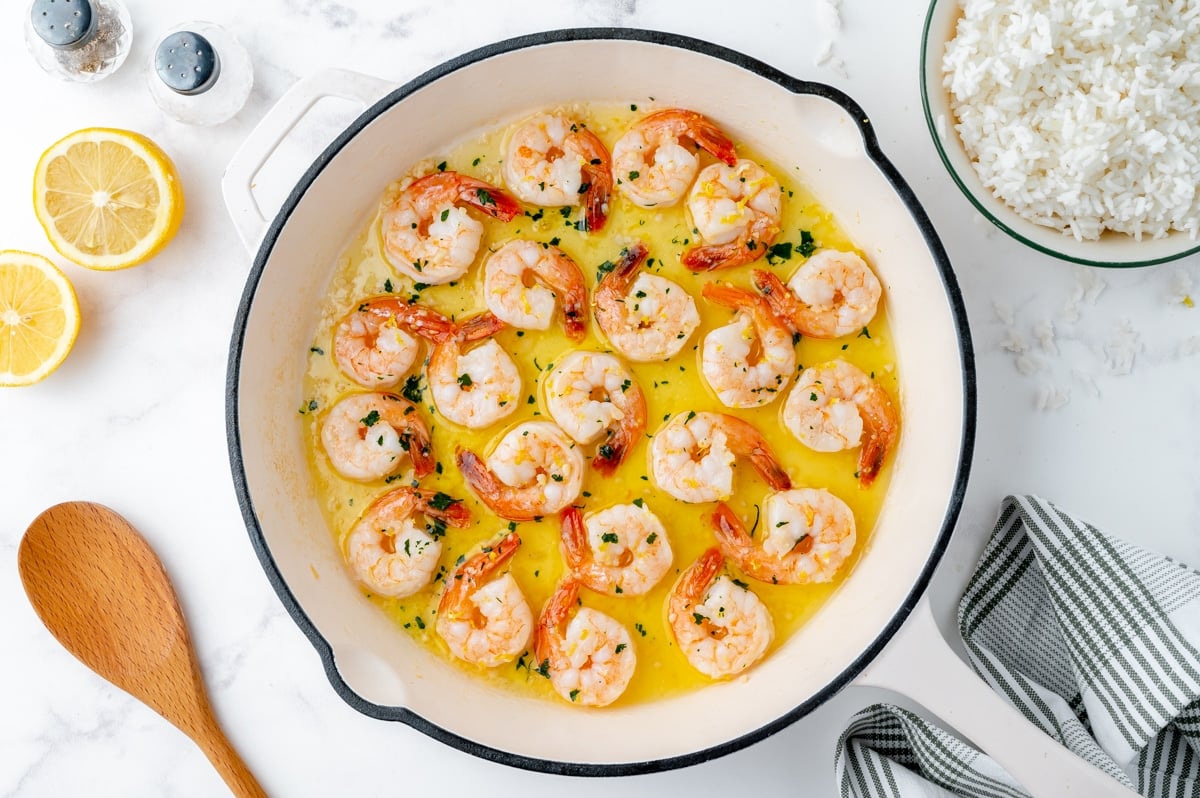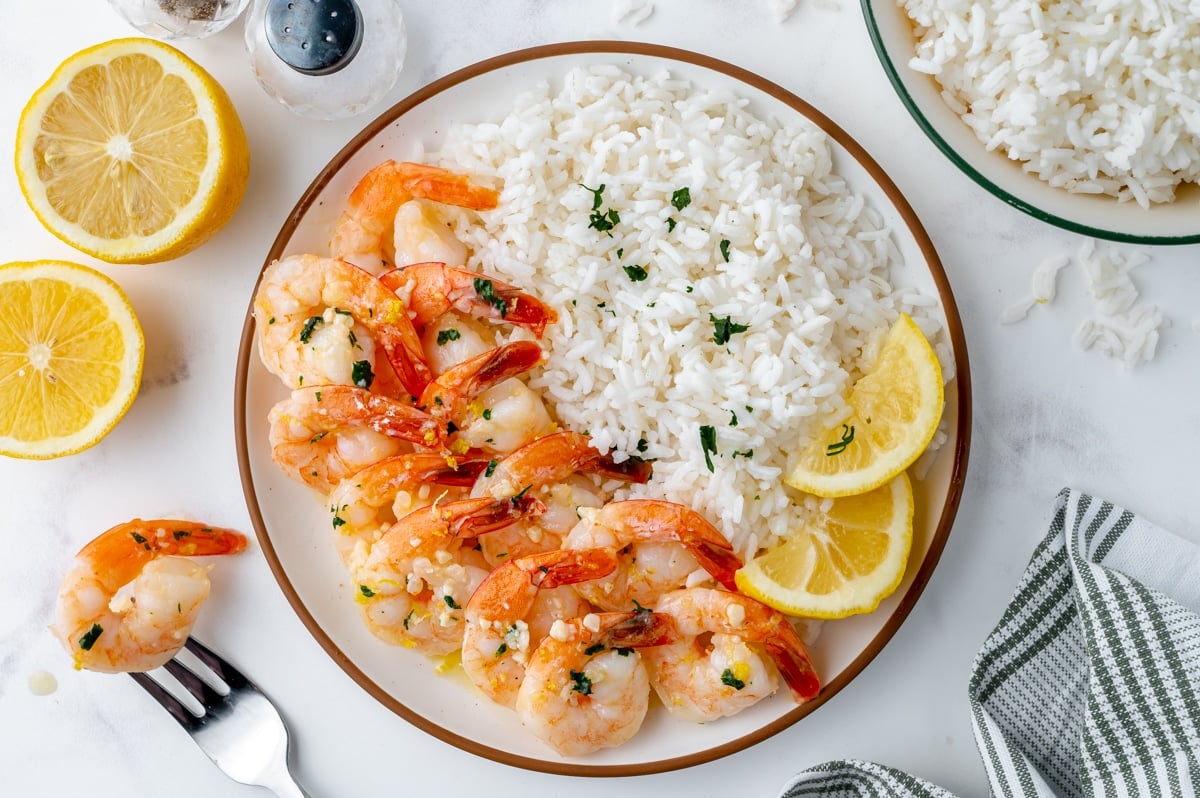A quick brine of salt, sugar, and water will make your shrimp taste better and make them incredibly tender and juicy, whether you’re making shrimp cocktail, ceviche, or shrimp scampi. A lot of people skip this step because they don’t know how to do it. That’s why this recipe says how to brine shrimp.
You can start with fresh shrimp or thawed frozen shrimp — either will work. After adding the shrimp, you only need to quickly stir the easy solution together and let it sit for a short time. Then you can use your favorite recipe to cook them.
Although there are other ways to brine shrimp, I like this one the best because it’s quick, easy, and only needs a few things. However, if you want to impart different flavors, you can add ingredients like bay leaves, spices, and herbs.
The next time you go to make shrimp, put aside a few extra minutes to brine them. You won’t regret it!.
The simple truth is that brining shrimp makes them plump and firm, and it also helps them stay juicy while you cook them. The salt water affects the structure of the protein in the shrimp, allowing them to become tender.
The sugar, on the other hand, affects the taste and appearance of the shrimp, rather than the texture. Thanks to the sugar, they are slightly sweeter and become more brown when cooked.
There’s no doubt that brining shrimp is the best way to make sure they are juicy no matter how you cook them.
Brining shrimp is an easy way to infuse flavor and enhance the texture of these tasty crustaceans before cooking. But a common question that arises is – should you rinse brined shrimp before cooking or not? In this comprehensive guide, we’ll examine if and when rinsing brined shrimp is recommended after taking a deep dive into the brining process.
Why Brine Shrimp in the First Place?
Brining involves soaking shrimp in a saltwater solution, traditionally made up of water, salt, and sometimes sugar or spices. This technique provides some great benefits:
-
Infuses the shrimp with seasoning throughout for enhanced flavor. The salt penetrates deep into the flesh.
-
Makes the shrimp plumper and juicier. The salt helps the shrimp better retain moisture when cooked.
-
Allows for quick seasoning Just a brief brine of 30 minutes or less seasons the shrimp versus marinating for hours.
-
Adds sweetness and enhances browning. Sugar in the brine caramelizes the shell for richer flavor and color.
So brining really takes shrimp from bland and dry to perfectly seasoned and succulent with minimal effort. It’s easy to see why it’s a popular preparation technique.
Step-by-Step Instructions for Brining Shrimp
Brining shrimp is simple to do at home with just a few basic steps:
-
Make the brine. Dissolve salt and any other flavorings like sugar, garlic, or lemon in cold water. Use a 3:1 ratio of water to salt.
-
Add the raw, peeled shrimp to the brine. Make sure they are fully submerged.
-
Refrigerate for 15 to 30 minutes. Due to their small size, shrimp brine quickly.
-
Remove the shrimp and pat them dry. Proceed with your cooking method.
-
Discard the used brine rather than trying to reuse or store it.
And that’s all there is to it! Now let’s explore the rinsing debate…
Should You Rinse Brined Shrimp? Pros vs Cons
There are good arguments on both sides whether rinsing brined shrimp is recommended or not:
Pros of Rinsing:
-
Removes excess salt from the exterior. This prevents over-salting the final dish.
-
Washes away spices and seasonings stuck to the surface. Results in a “cleaner” presentation.
-
Eliminates sticky brine residue. Some recipes like battered shrimp require rinsing.
Cons of Rinsing:
-
Waters down the seasoned flavor of the interior shrimp meat. Rinsing can dilute the brine’s effects.
-
Causes moisture loss. Patting shrimp dry after rinsing removes some of the added juiciness.
-
Washes off sugars and spices. These ingredients enhance browning and flavor.
-
Adds extra steps. Skipping the rinse streamlines the cooking process.
So in considering these pros and cons, when is rinsing your brined shrimp recommended?
Best Practices for Rinsing Brined Shrimp
Based on the above factors, here are some best practices to determine when you should rinse brined shrimp:
-
Rinse for a less salty flavor – If using an highly salty brine, rinsing removes some exterior salt for a more balanced end result.
-
Rinse when breading shrimp – Adhering a dry coating works best on rinsed shrimp. The brine can prevent coatings from sticking.
-
Rinse for shrimp cocktails or salads – A rinse produces a cleaner, fresher presentation for chilled shrimp dishes.
-
Don’t rinse for grilled or sautéed shrimp – The sugars and spices help with caramelization and flavor during cooking.
-
Skip the rinse to save time – When possible, pat dry rather than rinse to speed up the cooking process.
The ideal approach is to first brine some shrimp both rinsed and unrinsed to taste the difference. Then decide when you prefer rinsing based on your palate and recipe needs.
How to Properly Rinse Brined Shrimp
When you do opt to rinse your shrimp, follow these tips for best results:
-
Use cold tap water rather than warm to prevent premature cooking.
-
Do a quick 5 to 10 second dip rather than a prolonged soak.
-
Gently swish and move the shrimp continuously while rinsing.
-
Drain the excess water well after rinsing and pat shrimp very dry.
With this brief rinse, you remove surface brine while retaining the interior seasoning. Be sure to thoroughly dry the shrimp to prevent a diluted flavor.
What’s Next After Brining and Rinsing Shrimp?
Once your shrimp are brined and patted dry, they’re ready to cook as desired! Brined shrimp shine in these easy recipes:
-
Sautéed garlic butter shrimp – The brine really brings out the shrimp sweetness against the garlic and butter.
-
Baked coconut shrimp – Crispy coconut coating sticks beautifully to brined and rinsed shrimp.
-
Grilled shrimp skewers – Brining helps the shrimp stay juicy when exposed to the dry heat of the grill.
-
Shrimp tacos – Brined shrimp has so much flavor it needs just a squeeze of lime and serve in a warm tortilla.
Remember, the possibilities are endless for using brined shrimp in all kinds of dishes from appetizers to mains. Just adjust rinsing as needed based on the recipe.
Brining shrimp may seem like an optional extra step, but it truly elevates the end result with juicy, seasoned seafood. Follow these tips on whether or not to rinse, and you’ll be rewarded with perfect shrimp every time.

Best Shrimp Brine Recipe
You only need a few basic ingredients from the grocery store to both brine and cook the shrimp.
To Brine:
- Cold water—Make sure to use cold water so the shrimp stay safe while they’re brining.
- Coarse kosher salt—You can use any kind of salt you like, but this kind works well and dissolves pretty quickly. Sea salt is another good option.
- Grass sugar is the easiest type to use in this recipe.
- Large shrimp: Peel and devein your raw shrimp as a first step. Peeled shrimp will brine more quickly.
To Cook:
- Unsalted butter—This is the best kind of butter to use because the shrimp will still taste salty from the brine. You can add more salt once you’ve taste-tested.
- Garlic: Cut the garlic cloves into small pieces so there aren’t any big ones.
- Lemon—Use both the juice and the zest to get a strong lemon flavor.
- Flat leaf parsley: For the best look, cut the parsley into small pieces.

Other Easy How-Tos For Brining Protein

Big Mistakes Everyone Makes When Cooking Shrimp
Should you rinse shrimp after removing from brine?
One essential tip: don’t rinse shrimp after removing them from the brine. Simply pat them dry with a paper towel before seasoning or cooking. Rinsing the shrimp will remove the salt the shrimp have accumulated in the brine. Patting them dry is also essential, especially when pan-searing or grilling.
Can You brine shrimp?
Brine it! You read that right—you can brine shrimp! Here’s how. In a large nonreactive container, combine the water, salt, and sugar (if using), stirring to dissolve the salt and sugar. Transfer to a resealable bag, add the shrimp, and seal the bag, squeezing out as much air as possible. Set aside in the refrigerator 1 to 1 and ½ hours.
How do you brine deveined shrimp?
Pour water, salt and sugar into a large bowl and stir until the salt is entirely dissolved. Place the deveined shrimp in the bowl with the brining solution. Make sure that there’s enough brine solution so that the water level is above them all so that they brine evenly. Allow the shrimp to brine for the recommended amount of time.
How long do you brine shrimp?
Allow the shrimp to brine for approximately one hour. It’s important to note that shrimp is small in size and needs less time than larger proteins to absorb flavors fully. 4. Once the brining period is over, remove the shrimp from the brine and pat them dry with paper towels.
